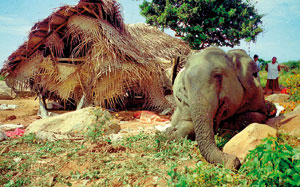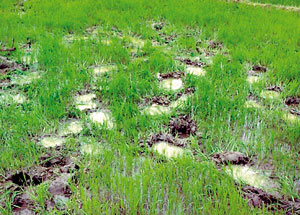What is Sri Lanka’s stance, conservationists both in the State and non-state sectors question, amidst howls of protest over the action that led to the cancellation in March of the World Bank’s US$30 million credit line for the much-awaited Ecosystems Conservation and Management Project (ESCAMP).
Attempting to do development without addressing problems caused by development and at the cost of our natural resources would appear to be very short-sighted and harmful to development itself and the country in the long run, stressed a perturbed conservationist.
Globally, with the consensus clearly being that conservation is not a whim but a necessity, particularly in the light of frequent natural disasters due to the abuse and misuse of the environment, Sri Lanka seems to be heading in the wrong direction to its detriment, another conservationist pointed out, a view echoed by a cross-section of people.
 |
| An elephant shot in the South and a paddy field in the North Western Province damaged by elephants (file pix) |
 |
The Sunday Times understands that the zero-interest credit line was cancelled by the World Bank because during the final stages, just before the signing of the agreement, “fundamental changes” completely altering the design and content of ESCAMP had been requested.
The irony, stressed another source, is that ESCAMP was tailor-made not by foreigners with agendas who were trying to foist western thinking on us, but by the experts in Sri Lanka who have been grappling with numerous environmental issues locally.
It was the Department of Wildlife Conservation (DWC) and the Forest Department officials which laboured for many months over the past two years and came up with what is of importance, and how best to address the issues concerned, the Sunday Times understands, with the Ministry of Environment and the Director of Policy Planning in the know along with the Finance Ministry, from its inception. Input to the project design had also been sought from many environmental activists and conservationists from the non-state sector, it is learnt.
Then what went wrong at the last minute, just before ESCAMP was finalized? Who or what institution, in fact, went against the specific objectives of none other than President Mahinda Rajapaksa himself who has laudably identified ‘Respect for fauna and flora’ in ‘Mahinda Chintana – Vision for the Future’?
These are the critical questions being posed by all and sundry who fear not only for the immediate but also the long-term future of this county which has had conservation as a priority since King Devanampiyatissa saw the light after the mango tree conversation with Mahinda Thera atop the Mihintale hill many centuries ago.
Currently, one of the important aspects that President Rajapaksa has targeted in the Mahinda Chinthanaya is the ‘Gaja Mithuro’ project that “seeks to ensure the co-existence of man and elephant, reducing the threat to the elephant population”.
“Unplanned development and terrorism have destroyed our national parks and sanctuaries. Consequently, elephants have invaded villages………..As a solution to this problem, I have implemented the ‘Gaja Mithuro’ programme in 2009. As a part of this programme ‘elephant control’ units and electric fences were established over 600 kms during the last year alone. I will complete these electric fences in all affected villages, including the north and the east, in the next three years,” according to the Mahinda Chinthanaya.The mitigation of the Human-Elephant Conflict (HEC) which is mainly caused by unplanned development, was in fact one of the major components of the scuttled ESCAMP, the Sunday Times learns, while the overall objective was to assist the Government to achieve the key elements of the country’s own Biodiversity Conservation Action Plan.
That is why ESCAMP identified as its focus the ecologically important regions from the southwest and central wet zone, the southeastern dry and arid zone, the mixed climatic zone ranging from the wet zone in parts of the Central Province to the intermediate and dry zones of the North Western, North Central, Northern and Eastern Provinces. (See box)
| The project that was cancelled |
ESCAMP was due to concentrate on four ‘conservation landscapes’ -- which are contiguous areas with unique ecological, cultural and socio-economic characteristics -- within the three priority climatic zones, the Sunday Times understands.
These conservation landscapes are dominated by Protected Areas (PAs) of both the DWC and Forest Department and also contain ecologically sensitive sites and wildlife corridors which are not falling within PAs.
The four identified landscapes were:
- Kanneliya-Dediyagal-Nakiyadeniya forest to Galways land sanctuary
- The Bundala National Park to the Maduru Oya National Park (the landscape with the largest PA network)
- Victoria-Randenigala-Rantembe to Pigeon Island Marine National Park
- From Bar Reef Sanctuary and Wilpattu National Park to Chundikulam Sanctuary, Kokilai Sanctuary to Kahala Pallekelle
The four main components of ESCAMP were:
- Promoting ecosystem conservation and management
- Demonstrating HEC management through co-existence
- Enhancing the quality of nature-based tourism in support of PA conservation and management
- Strengthening knowledge and national capacity for ecosystem conservation and management
|
These zones and therefore the chosen regions within these zones are the most sensitive areas with regard to biodiversity and threats due to development pressures, said a conservationist who was part of the discussions when finalizing ESCAMP.
Pilot projects that would try out and adapt management approaches with very good chances of mitigating the HEC were one of the main components of ESCAMP, said a disheartened elephant researcher stressing in no uncertain terms that the “loser” in the cancellation of this project is “conservation and especially elephants and rural men, women and children”. ESCAMP was to fund in its entirety, the action plan developed for ‘human elephant co-existence’ under the aegis of the Ministry of Economic Development when the Department of Wildlife Conservation was under it, and presented to the President himself, he said.
Lamenting that the cancellation of ESCAMP is a cruel death blow not only to elephant conservation but also HEC mitigation, another conservationist asked why the authorities were blind to the many human deaths as well as agonizing deaths of elephants which have been splattered by gun-fire or have swallowed hakka patas. He stressed that the human-elephant conflict is one of the main impediments to livelihood improvement in a large part of the country and a significant cause of economic loss and social strife, making it a major socio-economic and political issue.
Sixty years of failed elephant drives and translocations have shown that those are not the answers for the human-elephant conflict, he said, pointing out the fate of many of these majestic beasts.
One of them which shook the conscience of Sri Lanka was that of ‘Brigadier’ who was translocated but walked hundreds of kms, finally ending up in the sea and being rescued by Navy personnel (highlighted in the Sunday Times of June 6, 2010), only to die a lingering death.
ESCAMP was a tiny but very important step in the right direction. With even that small hope crushed, HEC will only escalate, with not only elephants outside Protected Areas but also many inside Protected Areas being killed along with the loss of many human lives and much suffering to man and beast, another said.
Sri Lanka will lose the unique position of being the best place in the world to watch Asian elephants, together with a golden opportunity of earning significant sustainable income from elephant viewing based tourism, he pointed out.
ESCAMP was directed towards developing the eco-tourism sector, which has a high potential to provide significant sustainable foreign income to Sri Lanka, said another source. While part of the project was designed to ensure conservation of the natural resources that is the basis for eco-tourism through better management of National Parks and enhancing the capacity of conservation agencies, other components of the project targeted developing the eco-tourism sector itself.
If ESCAMP indeed represented all these aspects that were for the betterment of the lives of the humble men, women and children in our villages, our environment and our country and was designed by our own professionals in the conservation sector, the question on everyone’s mind is: “Why was it scuttled?”
The obvious follow-up question is: Shouldn’t we get it back in its original form without the ‘fundamental changes’? |



